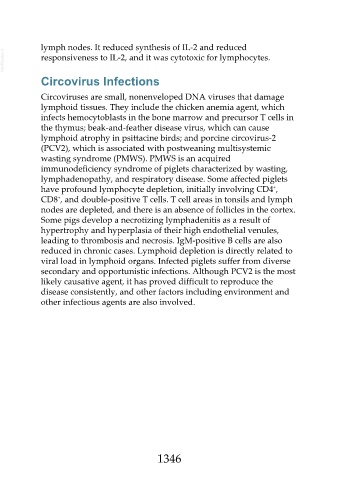Page 1346 - Veterinary Immunology, 10th Edition
P. 1346
lymph nodes. It reduced synthesis of IL-2 and reduced
VetBooks.ir responsiveness to IL-2, and it was cytotoxic for lymphocytes.
Circovirus Infections
Circoviruses are small, nonenveloped DNA viruses that damage
lymphoid tissues. They include the chicken anemia agent, which
infects hemocytoblasts in the bone marrow and precursor T cells in
the thymus; beak-and-feather disease virus, which can cause
lymphoid atrophy in psittacine birds; and porcine circovirus-2
(PCV2), which is associated with postweaning multisystemic
wasting syndrome (PMWS). PMWS is an acquired
immunodeficiency syndrome of piglets characterized by wasting,
lymphadenopathy, and respiratory disease. Some affected piglets
+
have profound lymphocyte depletion, initially involving CD4 ,
+
CD8 , and double-positive T cells. T cell areas in tonsils and lymph
nodes are depleted, and there is an absence of follicles in the cortex.
Some pigs develop a necrotizing lymphadenitis as a result of
hypertrophy and hyperplasia of their high endothelial venules,
leading to thrombosis and necrosis. IgM-positive B cells are also
reduced in chronic cases. Lymphoid depletion is directly related to
viral load in lymphoid organs. Infected piglets suffer from diverse
secondary and opportunistic infections. Although PCV2 is the most
likely causative agent, it has proved difficult to reproduce the
disease consistently, and other factors including environment and
other infectious agents are also involved.
1346

